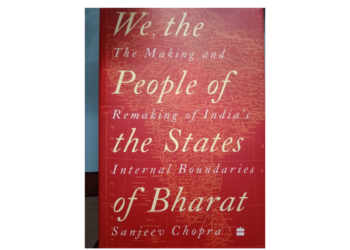The making and remaking of the states since 1947, from incorporation of the princely realms to formation of new states in contemporary times, is collated here in a handy and absorbing tome
BY DEEPAK GUPTA
Any student of history would be fascinated by the question of when India actually became a nation state. Its history, from earliest times, through empires and princely kingdoms, big and small, has been of shifting boundaries. It was only when we secured independence in 1947 that, in a sense, we acquired the geographical shape of today, threatened by the irresponsible claims of China and Pakistan. Further, we also emerged as a nation in the period 1946-50 with the herculean efforts of Sardar Patel and others as they incorporated the princely states into the Union, and later, the small foreign territories were added. And yet, no other country has been witness to such large-scale re-adjustment of internal boundaries thereafter. That in itself is reason enough for us to read We, the People of the States of Bharat. It is a rivetting story that has been told in great detail by writer, thinker and ex-IAS officer Sanjeev Chopra.
The political history and processes of post-Independence India have been well studied. However, the subject is so vast that it offers many different areas and perspectives for study. It is to the credit of Chopra that he has found a gap and has chronicled one important aspect which has been dealt with only in bits and pieces in the past in articles or reporting or even sections of books, and the like. He provides a holistic view and has put together all occurrences in one publication, perhaps for the first time. The reader at least has the opportunity to access all the related information in one place. Chopra has done so after a lot of research. His studies provide more than just a glimpse of what has gone into the making and remaking of states. There is plenty for any reader to dig into in whichever direction they may look from Madhya Bharat towards all the extremities. The extensive notes and bibliography show how painstaking the effort has been in putting things together and is inducement to further reading.

The changes or readjustments of the states/Union Territories have been caused by a mix of political issues, regional aspirations, the language divide, territorial legacies, religious matters, and, of course, external jurisdictions. This is another aspect of the phenomenal diversity within this ancient land bound together by a rich civilisational history and some concept of Indianness. The book covers all states as each has been affected by some change. I was struck with the new-found realisation that every state and UT (including Ladakh and the Andaman & Nicobar Islands) has seen a change in nomenclature or status or territorial adjustment since 1947, yet the country as a geographical entity has strengthened.
All of us should be aware of these historical developments because they are important for our understanding of the unity of India. As Chopra says, India has during these years, and with these developments, re-imagined itself—showing innovative ways of accommodating political, cultural and linguistic aspirations and differences. It is also a story then of statesmanship over a period of time where a broader vision of nationhood has prevailed.
The book covers all states. The story of each state is interesting in itself because it has its own background and interplay of different forces and aspirations. Many of us have seen most of these events happening but they are all worth looking back at again for a better understanding with both hindsight and the perspective of so much time having passed and considering the essentially holistic nature of the outcomes. But each is different in its own way, and actually very different, which makes for much variety.

Take the case of Sikkim, an important event which happened when I had just joined the IAS but of which there is only a dim recollection for me. Interestingly, there are four perspectives of the events briefly discussed in the book—written by journalists, civil servants and foreigners. What it shows is the interplay of various factors. Each is different. For the history student, reading them side by side would show that, as Chopra says, history is but an interpretation and perspective of facts, and no one, especially the contemporary observer, can claim to be ‘objective’. This approach will add spice when you read the many stories in this book.
I am, however, left with a sense of foreboding. The issue of political power has become increasingly dominant and there are new divisions developing within the country. Chopra notes that the formation of Telangana has rekindled hopes in Maharashtra and Bengal for a second state. There has been talk for long of Uttar Pradesh and Bihar being too big. At the same time, these states, particularly UP, has become the source of political power in the Union. If the growing demographic differentials lead to increased electoral constituencies making for an even higher number of Lok Sabha seats for these two states, there may be adverse reactions elsewhere, especially as there is some resentment at resources flowing from south and west to north and east. What next, the question Chopra asks, is therefore very important for the balanced growth of the country. His book provides all of us an opportunity, and a better understanding, to reflect upon these issues.
(The reviewer is former chairman, Union Public Service Commission.)








